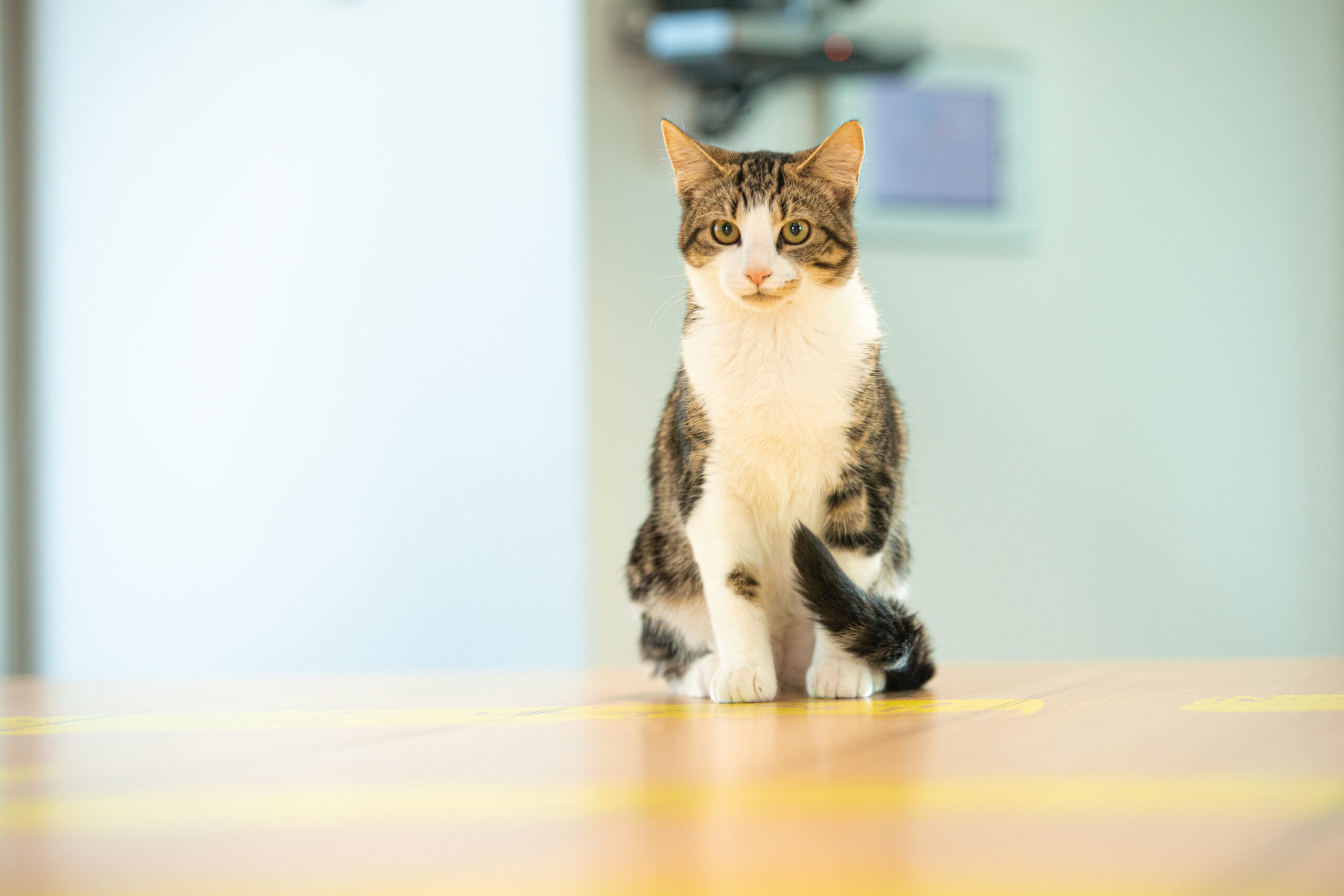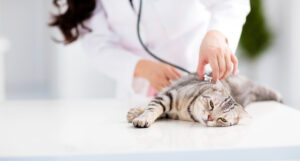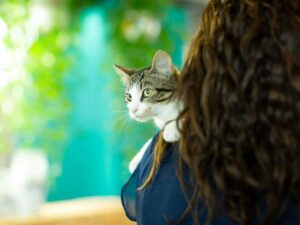Domestic shorthair cat | Breed highlights
| Breed: | Domestic shorthair cats are not a recognised cat breed: the term refers to short-haired cats of mixed ancestry. |
| Coat type: | Coat types can vary. The fur can be short and sleek, sitting close to the body or can be denser and fluffier in appearance. |
| Shedding: | Shedding depends on coat type; however, expect more shedding during Spring and Autumn. |
| Grooming: | Minimal grooming is required. Weekly brushing is adequate to remove any excess fur. |
| Activity level: | Domestic shorthair cats are natural hunters; they tend to be more active at night when these instincts are activated. |
| Apartment friendly: | Yes |
| Small children: | Yes (supervision with children is always recommended).. |
| Other pet friendly: | Yes |
What type of breed is a domestic shorthair cat?
The domestic shorthair, also referred to as a moggy or housecat, is a mixed breed, medium-sized cat. One of the most popular cat types, the domestic shorthair cat, is hardy and adaptable. Their appearance ranges across the cat spectrum and comes in every possible colour and pattern. Mostly the domestic shorthair is seen in traditional Tabby shades of brown and black with splashes of white. Thanks to exceptional hunting abilities, domestic shorthair cats are considered working cats and have been used for centuries to keep rat and mouse populations at bay.
History of the domestic shorthair cat
The domestic cats origins can be traced back to Egypt in 2000 BC, where historians claim cats from the wild migrated to human settlements because of an abundant food source: rodents. Cats living alongside humans over the millennia earned their keep through exceptional hunting abilities. This skill saw them board ships from Europe to other parts of the world as early as the 16th century. During the late 18th and early 19th century, pet keeping became more acceptable, giving rise to cat breeders, who, as well as developing pedigree lines, produced variations of domestic shorthair cats in colours they are recognised for today.
Domestic shorthair cat appearance and characteristics
Domestic shorthair cats range from medium to large-sized, have a muscular build, and can weigh between 3 to 6 kilograms. Their short fur – which can be sleek or coarse – tends to sit close to the body; however, fur length may vary.
Because domestic shorthair cats have bred over myriad cat lines, they come in various colours and fur patterns. While the Tabby pattern is probably the most recognisable, domestic shorthair cats also come in black, black and white (tuxedo), tortoiseshell (bi-coloured coats), ginger, calico (tri-coloured coats), grey, lilac, white, or mix of colours. Eye colour varies from golden-hued to green or blue.
Domestic shorthair cat personality and temperament
This breed is generally playful, friendly and adaptable. That said, they have a wide range of personalities. Some are outgoing and rambunctious and are happy to play with anyone, while others may be shy, preferring the company of someone they are bonded to. Generally, the breed isn’t highly strung or anxious, and even those with more cautious temperaments often reveal they are as interactive as those with more outgoing natures.
Domestic shorthair cat breed traits
Domestic shorthair cats instinctually wants to hunt. This trait will be apparent when they are young kittens and may continue into more mature years. While a helpful attribute if employed to keep mice and rats at bay, their hunting instinct can be problematic for native species. This is one great reason to keep all cats safely indoors or in a special cat enclosure. Another great reason is so that they avoid hazards like roads, ticks, snakes and fighting with other cats, which can expose them to infections like FIV.
The perfect cat enclosure contains lots of toys, cat scratchers, windows to access fresh air and outside views, cat grass to enjoy, and room for zoomies.
Domestic shorthair cat lifespan
Domestic shorthair cats can live up to 20 years old. On average, they live between 12 – 18 years.
The dos and don’ts of caring for a domestic shorthair cat
Do: Include plenty of scratching posts for indoor-dwelling cats. All cats instinctively sharpen their nails, and without a post, they can use – and potentially destroy – soft furnishings or carpets.
Don’t: Overfeed. Domestic shorthair cats are prone to overeating. Overweight cats are at higher risk of having health problems like Feline Lower Urinary Tract Disease, diabetes and mobility problems like arthritis.
Do: Take them to the veterinarian for regular check-ups. Even though the Domestic Shorthair Cat may appear tougher than their pedigree counterparts, they still require regular check-ups and preventative care.
Common Conditions for the domestic shorthair cat
| Conditions | Symptoms can include~ | Highest cost for a single treatment* |
| Gastrointestinal Tract Diseases | · Diarrhoea, vomiting or constipation · Blood or mucous in stool/vomit · Increased frequency/urgency passing stool · Weight loss · Changes in appetite · They may seem more tired than usual | $22,115 |
| Otitis Externa (ear infection) | · Scratching, rubbing or pawing at one or both ears ·Head shaking ·Odour or discharge from the ears ·Ears may be red or warm to the touch | $7,771 |
| Feline Lower Urinary Tract Disease (FLUTD)on/Obstipation | · Straining in litter box · Frequently visiting litter box · Passing small volumes of urine · Crying when urinating · Licking at the genitals · Urinating in inappropriate locations · Blood or discoloured urine | $19,414 |
| Traumatic Injuries including road accidents, cat fight | ·History of trauma ·Wounds ·Bleeding, swelling, heat, pain ·Limping, changes to movement ·Behaviour changes ·Broken claws ·Pain/tenderness | $7,449 |
| Allergic skin disease | ·Excessive grooming or scratching ·Hair loss ·Scabby skin ·Wounds, grazes, ulcers, open sores on the skin ·Ear infections | $4,210 |
Disclaimer: Reimbursement for these claims would be subject to limits, such as annual benefit limits or sub-limits, benefit percentage, applicable waiting periods and any applicable excess. Cover is subject to the policy terms and conditions. You should consider the relevant Product Disclosure Statement or policy wording available from the relevant provider.
* Please note that the values calculated are based on all claims for that condition and medically related conditions in each calendar year.
Types of pet insurance from PetSure
The different types of pet insurance from PetSure include:
| Accidents | This product provides cover for specified traumatic accidental injuries up to an annual policy limit, which is usually between $8,000 – $15,000. It’s important to know that only defined accidents, as listed in the policy’s Product Disclosure Statement, will be covered (other accidents and illness conditions will not be covered). More information on what is typically covered and not covered in our find a policy page. |
| Basic care | This product provides more limited cover for both accidental injuries and illness conditions, with a stated Benefit Percentage that can range from 60-90%. Treatments and medications for eligible conditions are typically covered subject to the applicable policy limits. More information on what is typically covered and not covered in our find a policy page. |
| Indoor cats | This product provides cover for a list of specified conditions, tailored to the needs of indoor cats (who lead a very different lifestyle to cats that can also venture outdoors). With a stated benefit percentage that’s typically 80%, you can claim up to an annual maximum limit each year, which resets on renewal. More information on what is typically covered and not covered in our find a policy page. |
| Comprehensive / Accident and Illness | This product provides comprehensive cover for both accidental injuries and illness conditions, with a stated Benefit Percentage that will typically range from 70-85%. You can claim up to an annual maximum limit each year, which resets on renewal. sub-limits for certain items may also apply. More information on what is typically covered and not covered in our find a policy page. |
Pet insurance can help by covering a portion of the eligible vet bill if the unexpected happens. Because it is difficult to predict the costs of veterinary care, it can help to have measures in place to help prepare for the unexpected. Check out our partner network and explore our policy tools to find a pet insurance policy. Not all conditions or items are covered by Pet Insurance. Refer to the applicable Product Disclosure Statement for information about coverage and exclusions.
Insurance products are issued by The Hollard Insurance Company Pty Ltd ABN 78 090 584 473, AFSL 241436 (Hollard) and/or PetSure (Australia) Pty Ltd ABN 95 075 949 923, AFSL 420183 (PetSure) (from 8 May 2023 only), administered by PetSure and promoted and distributed through their authorised representatives and distribution partners.
Any advice provided is general only and does not take into account your individual objectives, financial situation or needs. Cover is subject to the policy terms and conditions. Please consider the Product Disclosure Statement (PDS) to ensure this product meets your needs before purchasing, or choosing to continue with the product. PDS and Target Market Determination available on our partners’ websites. Meet our partners at petsure.com.au/partners.
Frequently Asked Questions
Yes, all cats need exercise. Providing plenty of furniture that they can climb and play on is important as well as dedicated play time together. Feeding cats with treat balls or puzzle feeders is a great way to exercise not only the body, but also the mind.
Cats sleep a lot but have short bursts of energetic play time in between sleep marathons. The early evening is often a time where cats have a big playtime. When you notice your cat up and about, this is a great opportunity to see if they want to engage in some play. Many cats will enjoy chasing after balls, wands or laser pointers, as well as solving problems like the previously mentioned puzzle feeder.
All cats need to scratch to keep their nails healthy, express emotions, and scent mark. If living indoors, cats may use furniture or carpet for this purpose. Introduce scratching posts and various other appropriate items for them to scratch with a variety of textures, shapes, and heights to stimulate them to scratch those.
References
Cats Domesticated Themselves, Ancient DNA Shows
The Domestic Cat: The Biology of its Behaviour. 3rd edition, November 2013, Edition: 3rd Publisher: Cambridge University Press Editor: Turner DC Bateson PISBN: 978-1-107-02502-8
Wikipedia, Domestic short-haired cat
Pet insurance can help by covering a portion of the eligible vet bill if the unexpected happens. Because it is difficult to predict the costs of veterinary care, it can help to have measures in place to help prepare for the unexpected. Check out our partner network and explore our policy tools to find a pet insurance policy.
Not all conditions or items are covered by Pet Insurance. Refer to the applicable Product Disclosure Statement for information about coverage and exclusions.



 Fact checked
Fact checked





